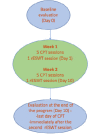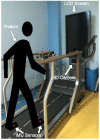Conventional physical therapy combined with extracorporeal shock wave leads to positive effects on spasticity in stroke survivors: a prospective observational study
- PMID: 37667862
- PMCID: PMC10583146
- DOI: 10.4081/ejtm.2023.11607
Conventional physical therapy combined with extracorporeal shock wave leads to positive effects on spasticity in stroke survivors: a prospective observational study
Abstract
The study aimed to evaluate the effectiveness of radial extracorporeal shock wave therapy (rESWT) and conventional physical therapy (CPT) protocol on the gait pattern in stroke survivors through a new gait analysis technology. Fifteen (n=15) stroke survivors took part in this prospective, observational study and were assessed clinically and through an instrumented treadmill before and after rESWT and CPT. Spasticity grade 95% CI 0.93 (0.79 +/- 1.08), pain intensity 95% CI 1.60 (1.19 +/- 2.01), and clonus score decreased significantly 95% CI 1.13 (0.72 +/- 1.54). The sensorimotor function 95% CI -2.53 (-3.42 +/- 1.65), balance 95% CI -5.67 (-6.64 +/- - 4.69), and gait parameters were enhanced at the end of the program. Step length 95% CI -3.47 (-6.48 +/- 0.46) and step cycle were improved 95% CI -0.09 (-0.17 +/- -0.01), and hip 95% CI -3.90 (-6.92 +/- -0.88), knee 95% CI -2.08 (-3.84 +/- -0.32) and ankle flexion-extension 95% CI -2.08 (-6.64 +/- -4.69) were augmented. Adding the quantitative analysis to the clinical assessment, we gained easy access to track progress and obtained an individualized therapeutic approach for stroke survivors.
Conflict of interest statement
We confirm that we have read the Journal’s position on issues involved in ethical publication and affirm that this report is consistent with those guidelines.
Usually, the rehabilitation of post-stroke patients is a long-term process involving multiple assessments. However, during the pandemic of COVID-19, the access to healthcare delivery throughout the world has been significantly impacted creating collateral damages for both, rehabilitation facilities and stroke survivors.
One of the key changes implemented by the health care systems in order to promote rehabilitation continuity, was the rapid expansion of several TR programs and tele-assessments strategies., Systems such as newly instrumented treadmills for spatiotemporal, kinematic, and kinetic parameters assessment with good levels of agreement, seem a new alternative to previous overground gait analysis systems. Integrating clinical assessment and virtual evaluation can easily offer objective data by tracking progress and also give the possibility to a tailored treatment for patients based on their performance at different moments.
Among the emerging therapies, extracorporeal shock wave therapy (ESWT) is a non-invasive therapeutic intervention used for musculoskeletal disorders, several inflammatory tendon diseases, or spasticity. The findings suggest that ESWT may be useful in decreasing plantar flexor muscle tone for adults and children affected by lower limb spasticity., There are some trials which had also showed that radial extracorporeal shockwave therapy (rESWT) was more effective on augmenting the ankle passive range of motion (PROM) compared to focal extracorporeal shockwave therapy (fESWT)., In addition, ESWT proved to be effective not only as treatment for lower limb spasticity, but also for gait pattern since combined with a conventional physical therapy (CPT) program decreased spasticity and improved gait pattern in children with hemiplegic cerebral palsy (CP). The findings on ESWT effectiveness for gait pattern improvement could open a new paradigm applicable for the research of this promising, non-invasive therapy already effective for spasticity management.
Added to clinical evaluation, the instrumented treadmills serve both as a tool for gait training and also for recording and measuring spatiotemporal and kinematic parameters, offering objective data for gait analysis, especially after treatment delivery., Gait analysis through systems such as instrumented treadmills play an important role in clinical practice and clinical trials by assessing gait patterns related to various disorders. This type of analysis through instrumented treadmills is based on measurements which offer the possibility for repeatability. Through the inertial measurement units (IMUs) usage it is granted good validity and reliability for mean spatiotemporal parameters during gait phases. Although there are trials validating different types of 3D cameras for gait analysis on the treadmills and overground, only few of them assessed the instrumented treadmills. However, there are gait analysis systems which showed good levels of agreement, and added to the clinical assessment provide the assessor with objective, real-time data.,,
Therefore, the aim of this study is to objectively evaluate the effectiveness of rESWT and CPT protocol on the gait pattern in stroke survivors through a new gait analysis technology. This type of technology encompasses spatiotemporal and kinematic parameters, and the findings are correlated with the clinical evaluation, offering a global assessment of gait parameters.
Figures




References
-
- Zhang M, You H, Zhang H, Zhao W, Han T, Liu J, Jiang S, Feng X. Effects of visual feedback balance training with the Pro-kin system on walking and self-care abilities in stroke patients. Medicine (Baltimore). 2020. Sep 25;99(39):e22425. doi: 10.1097/MD.0000000000022425. PMID: 32991477; PMCID: PMC7523840. - PMC - PubMed
-
- Bravi M, Massaroni C, Santacaterina F, Di Tocco J, Schena E, Sterzi S, Bressi F, Miccinilli S. Validity Analysis of WalkerViewTM Instrumented Treadmill for Measuring Spatiotemporal and Kinematic Gait Parameters. Sensors (Basel). 2021. Jul 14;21(14):4795. doi: 10.3390/s21144795. PMID: 34300534; PMCID: PMC8309770. - PMC - PubMed
-
- Mohan DM, Khandoker AH, Wasti SA, Ismail Ibrahim Ismail Alali S, Jelinek HF, Khalaf K. Assessment Methods of Post-stroke Gait: A Scoping Review of Technology-Driven Approaches to Gait Characterization and Analysis. Front Neurol. 2021. Jun 8;12:650024. doi: 10.3389/fneur.2021.650024. PMID: 34168608; PMCID: PMC8217618. - PMC - PubMed
-
- Papathanasiou J, Kashilska Y, Bozov H, Petrov I, Masiero S. The outbreak of the SARS-CoV-2 Omicron variant make imperative the adoption of telerehabilitation in the Bulgarian health care system. Eur J Transl Myol. 2022. Feb 2;32(1):10355. doi: 10.4081/ejtm.2022.10355. PMID: 35107088; PMCID: PMC8992671. - PMC - PubMed
LinkOut - more resources
Full Text Sources

